CW77 February, 2023
Preparing for post-pandemic lives
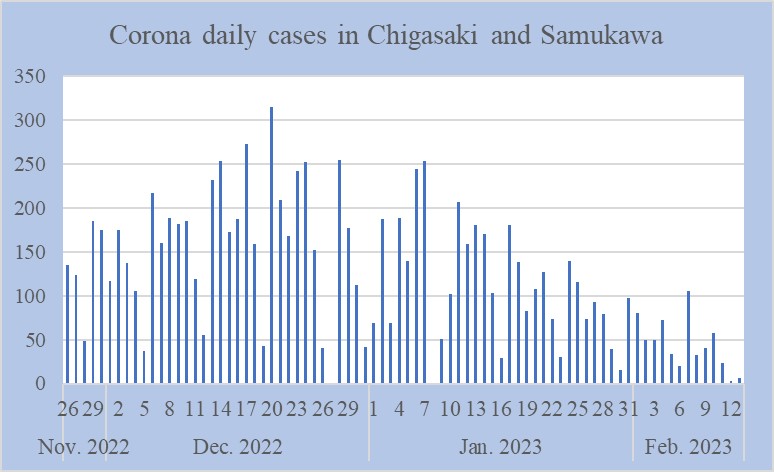
The eighth wave is apparently subsiding these days. See the figure above. Society has been preparing for post-pandemic lives. The government has decided that wearing a mask will not be required on and after March 13 (Mon). The health ministry says, “You do not need to wear a mask indoors when you are approximately two meters apart from others and when you are not talking.” To mask or not will be up to us. However, the ministry recommends that when we go to hospitals, or get on crowded trains or buses, we should wear masks. Many schools are worrying about whether students and staff should wear masks or not as the new school year approaches.
The government has also decided that COVID-19, currently ranked at Category II, will be downgraded to Category V effective on May 8 (Mon). Diseases classified as Category II, the second most serious infectious diseases in Japan, include tuberculosis and SARS, whilst those in Category V, the lowest category, include seasonal flu and syphilis. The following rules will be applied after COVID-19 shifts to V.
●Hospitals: not only fever clinics and other designated hospitals but ordinary hospitals will be able to treat corona patients.
●Medical expenses: PCR tests and hospitalization will be free for the time being, but patients will be charged in the future.
●Inoculation: the government intends to continue free inoculations. The next may be conducted in autumn.
Medical experts say we have to continue anti-infection measures after COVID-19 is demoted to the lowest category, as the shift does not mean that the pathogenicity of the virus has decreases.
Numbers of traffic accidents and injured people decreased in 2022
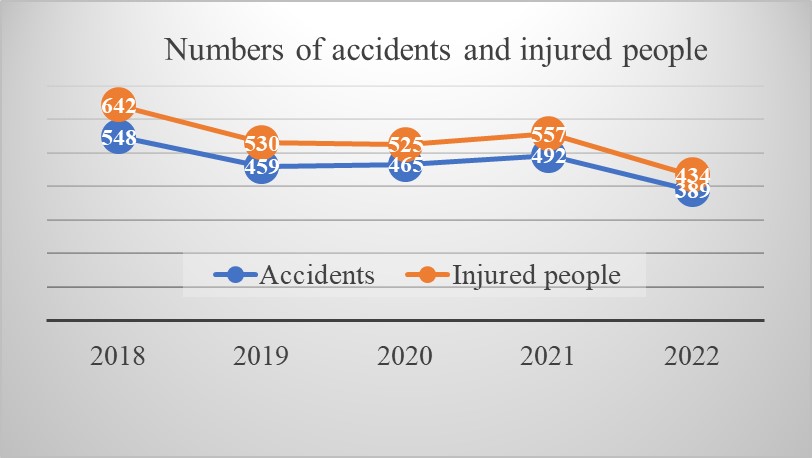
The Chigasaki police station has reported that the numbers of traffic accidents and injured people in 2022 decreased from 2021, and were the smallest in the past five years. See the figure above.
Of 389 accidents, rear-end collisions, collisions at intersections, and accidents involving pedestrians crossing the street were the top-3 types, and the total of these three reached 217 (55.8%). Among 434 injured people, nearly 96% suffered only slight injuries.

The numbers of accidents involving elderly people, bicycles, or motorcycles also decreased from 2021, and for each category the 2022 figures were the smallest in the past five years. See the chart above. As for data organized by road, 232 accidents (59.6%) happened on municipal roads, followed by those on R1 and R134.
“The corona pandemic subsiding, traffic safety lessons, patrol, and other activities by police officers have returned to normal, which contributed to the 2022 results,” says the police station. “Besides, citizens ride bicycles and motorcycles more carefully.”
For more data, go to https://www.police.pref.kanagawa.jp/ps/67ps/67pic/67000_tra3.pdf
Flowers of the Season: Japanese andromeda

Japanese andromeda is an ericaceous evergreen shrub. It grows wild in the main island of Honshu, Shikoku and Kyushu. The plant contains grayanotoxin and other poisonous substances so grass-eating animals avoid the plant, thus you can often see the trees around the mountains. In Hakone, the plant is abundant. Its Japanese name 馬酔木 (Asebi, meaning horses get drunk on the plant) is derived from the fact that when horses eat the plant, these horses behave as if they were drunk.
In early spring (February to April), the plant blooms clusters of small white globular-bowl-shaped flowers at the tips of branches which shot a year earlier. The paniculate inflorescence hangs down about ten centimeters. Alternate oval-shaped leaves are three to eight centimeters long, and have saw-tooth edges. They gather at the tips of branches. Vivid red shoots are conspicuous. Trees older than 100 years grow to five meters high, and their bark quirks. Some cultivars have pink blossoms which bloom upward.
Japanese people have gotten familiar with Japanese andromeda since ancient times, and the oldest anthology, “The Anthology of Myriad Leaves”, which was compiled from the late 7th to early 8th century, contains ten poems (thirty-one syllable Tanka) about the tree. 馬酔木 is also one of the Haiku season words, indicating spring.
The tree native to Japan has tolerance of both cold and dry climates, and is fond of semi-shadow places in groves and the gravel ground. Water soaking leaves and a decoction were once used for the extermination of harmful insects.
History of Chigasaki: Akabane Village (1)
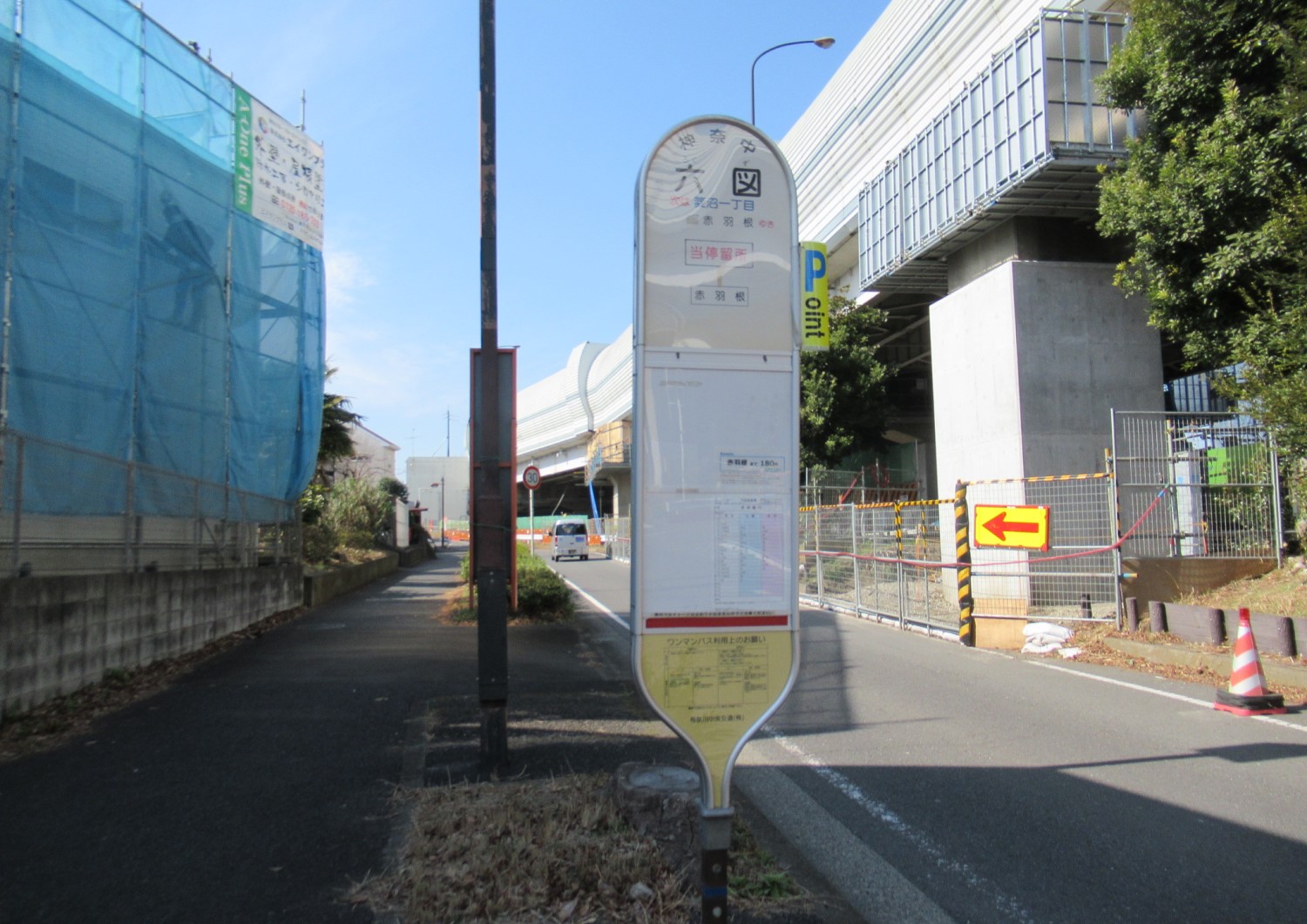
To the north of Kowada Elementary School, there is a bus stop named “Rokuzu” on the footage road of Shin-Shonan Bypass. The strange name was originally the name of the small section around the bus stop.
In the 1870s, the village office of Akabane divided the village into 15 sections, and numbered them from 1 to 15, and drew a map for each section. In the maps, rice paddies, farmland, housing lots, forests, and other land-use classifications were recorded. The serial number is called地番 (Chiban), and the map was called 字限図 (Azakirizu). Each of the fifteen maps was named 一図 (ichizu), 二図 (nizu),・・・十五図 (jugozu), and 六図 (rokuzu) is the sixth among them.*
*一, 二, 三, ・・・, 六,・・・ 十五 means 1, 2, 3,・・・, 6, ・・・15
Azakirizu was made not only in Akabane but in all villages in Japan. Each map was generally called Koaza, or a small section. Namely, 一図, 二図・・・are considered to be Koaza. Many villages used a characteristic land-use classification of each small section as its name, but some villages, like Akabane, used only serial numbers.
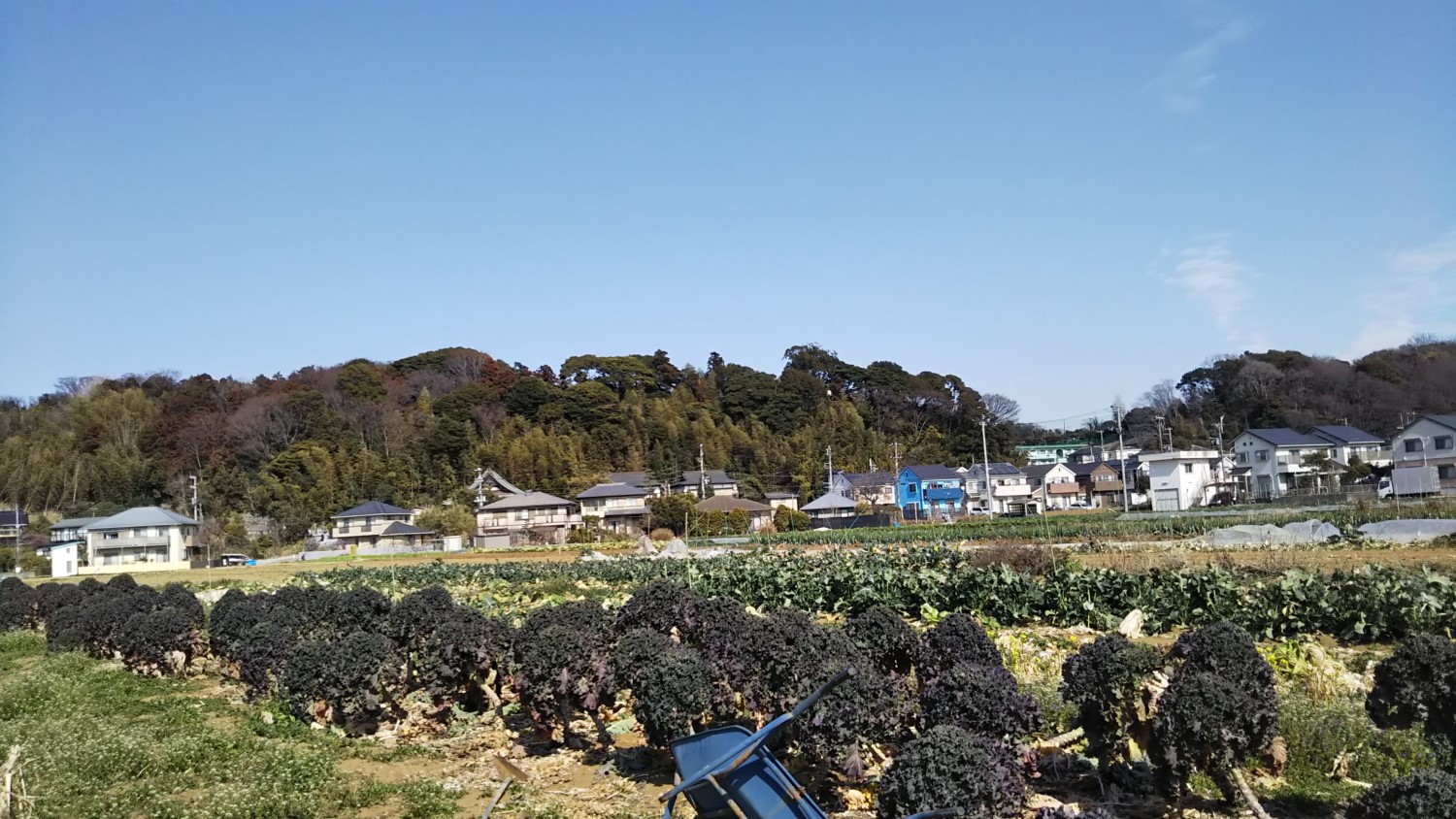
In the Edo period, or before the year 1868, villages were ruled by the Edo (Tokugawa) shogunate, feudal domains, or direct retainers of the shogun, and villagers paid rice, money, and other materials as a tax to the ruler. However, these tax systems varied from village to village, so that the Meiji government, which had replaced the Edo (Tokugawa) shogunate, and ruled across the nation, had to standardize the tax system. In addition, lords in the Edo period collected rice as an annual land tax from villagers, but such payment in kind was inappropriate to plan the nation’s annual budget. Thus, the government had to change the tax to cash payment. In 1873, the government decreed the regulation of the land-tax reform, and began to require villagers to pay money commensurate with the price of their land.
Interested in Japanese proverbs?
1) 危ない所に登らねば熟柿は食えぬ (ABUNAI TOKORO NI NOBORANEBA JUKUSHI WA KUENU)
ABUNAI means dangerous, TOKORO a place, NI to, NOBORANEBA unless you climb, JUKUSHI fully ripe persimmons, WA a preposition for an object, and KUENU unable to eat.
As delicious ripe persimmons grow on high thin branches, you cannot relish the fruits unless you climb there, which requires taking a risk. If you want to make big money, you have to venture into a big high-risk and high-return business. Ambition is not bad especially for young people. Strong desire to do something makes them work hard, and provides an axis for their lives.
The saying is in 類聚世話百川合海 (Ruiju-sewa-hyakusen-gakkai), a collection of proverbs published in 1766.
Its English equivalents are:
● Nothing ventured, nothing gained.
● Danger and delight grow both upon one stalk.
● The best fish swim near the bottom.
2) 合わせ物は離れもの(AWASE-MONO WA HANARE-MONO)
AWASE-MONO means an item made with many parts, WA to be, and HANARE-MONO an item that easily separate into original parts.
Even if you make a wonderful ornament by putting parts together, it may decompose into original parts with the lapse of time. Some couples, even if they are married, may have reason to separate someday. Relationships between married or unmarried couples may be more fragile than they think. Be kind to your partner! The saying also indicates that after you die, your body separates into inorganic compounds such as water, carbon dioxide, calcium and other simple compounds.
The saying is in 古今夷曲集(Kokin-ikyoku-shu), the first quality anthology of comical and satirical tanka poems, published in 1666.
Its English equivalents are:
● What hands built, hands pull down.
● Easily joined, easily separated.
● Meeting is the beginning of parting.
Short Essays on Chigasaki-1 Jinji & Banba (Bimonthly serial)
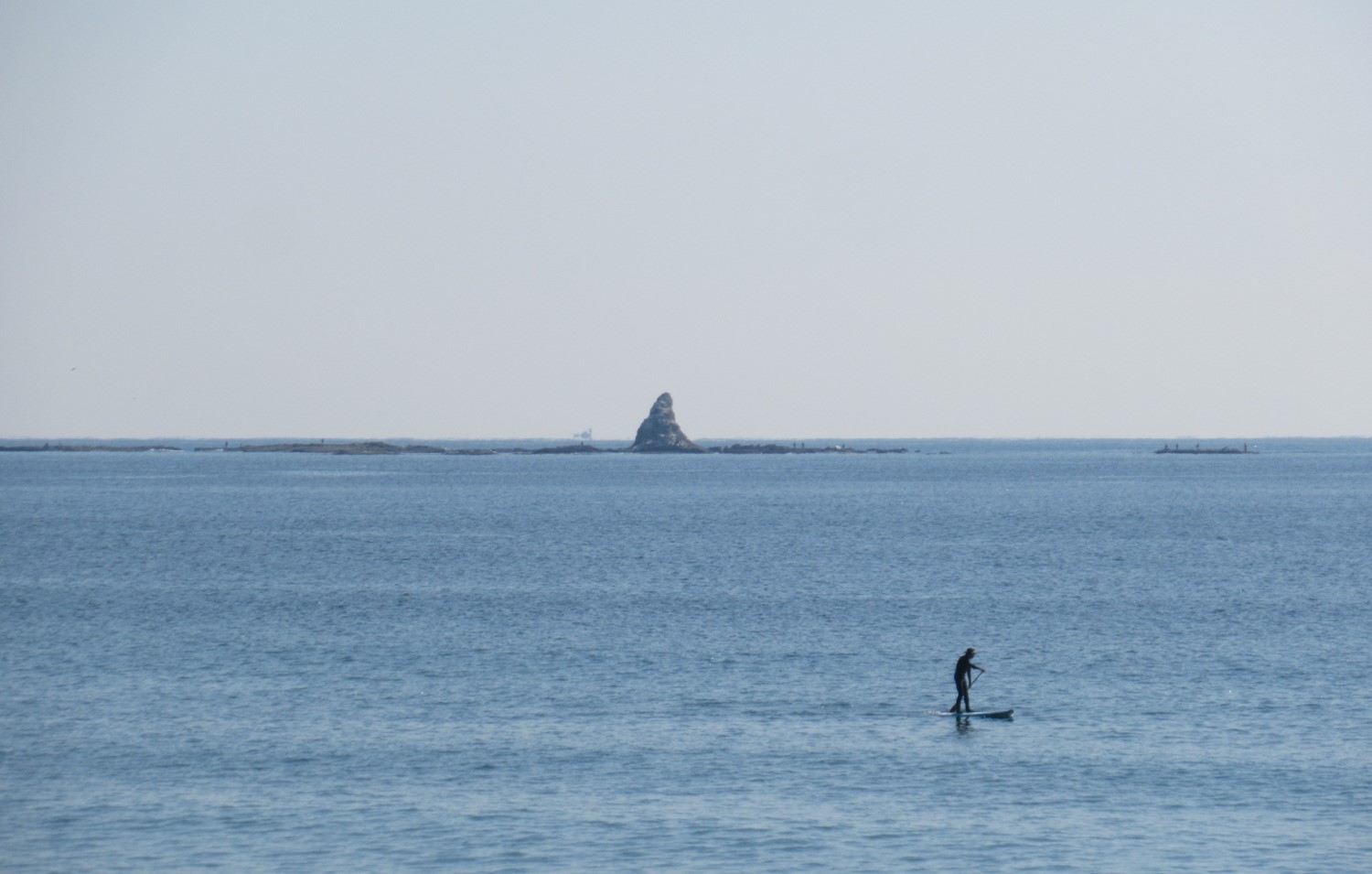
A reef lies 1.4 km off the coast of Chigasaki. It is called Uba-jima (an aged-woman island), or more popularly as Eboshi-iwa, a symbol of Chigasaki.
The sediment which became Uba-jima later was created on a 12- million-year-old stratum consisting of volcanic rocks and hard clay. The stratum was on a southern seabed around 1,000 km away from the coast. The seabed started moving to the north 4 cm a year long ago. When it clashed with the Japanese Archipelago, the sediment rose out of the sea, and became Uba-jima.※ It is an ancient volcano which emerged in the dim and distant past, compared to Mt Fuji and Mt. Hakone, which emerged a mere 100,000 and 400,000 years ago, respectively.

There is a legend in Kowada about Okina-jima (an aged-man island) and Uba-jima. Long time ago, this pair of reefs, lay in the ocean together, but the Okina-jima suddenly disappeared, and the Uba-jima continues to wait until he comes back. At the Kumano Shrine in Kowada, a stone monument on which the following poem is engraved stands. It says, “At Kowada in Sagami Bay, Uba-jima is falling asleep alone while she is waiting for someone.”
Kunio Yanagida, a folklorist, who used to live in his villa in Chigasaki, described the pair of reefs in his book, ‘Santo Mintanshu-II’ (山島民譚集). “Senior citizens living in Chigasaki called the two islands Jinji & Banba. At present, it is a solitary island, but the two islands used to be a married couple. She may have lost her husband in a storm in the past.”
※the shape of Uba-jima in the past was different from that of today. This is due to the US Army’s shooting training after WWII, aiming at the reef, and the top of the reef was blown away. At that time, a civil movement to protect the symbol of Chigasaki stopped the training.
(Source: Chigasaki People’s Book published by Chigasaki City)
New exhibitions at Chigasaki City Museum
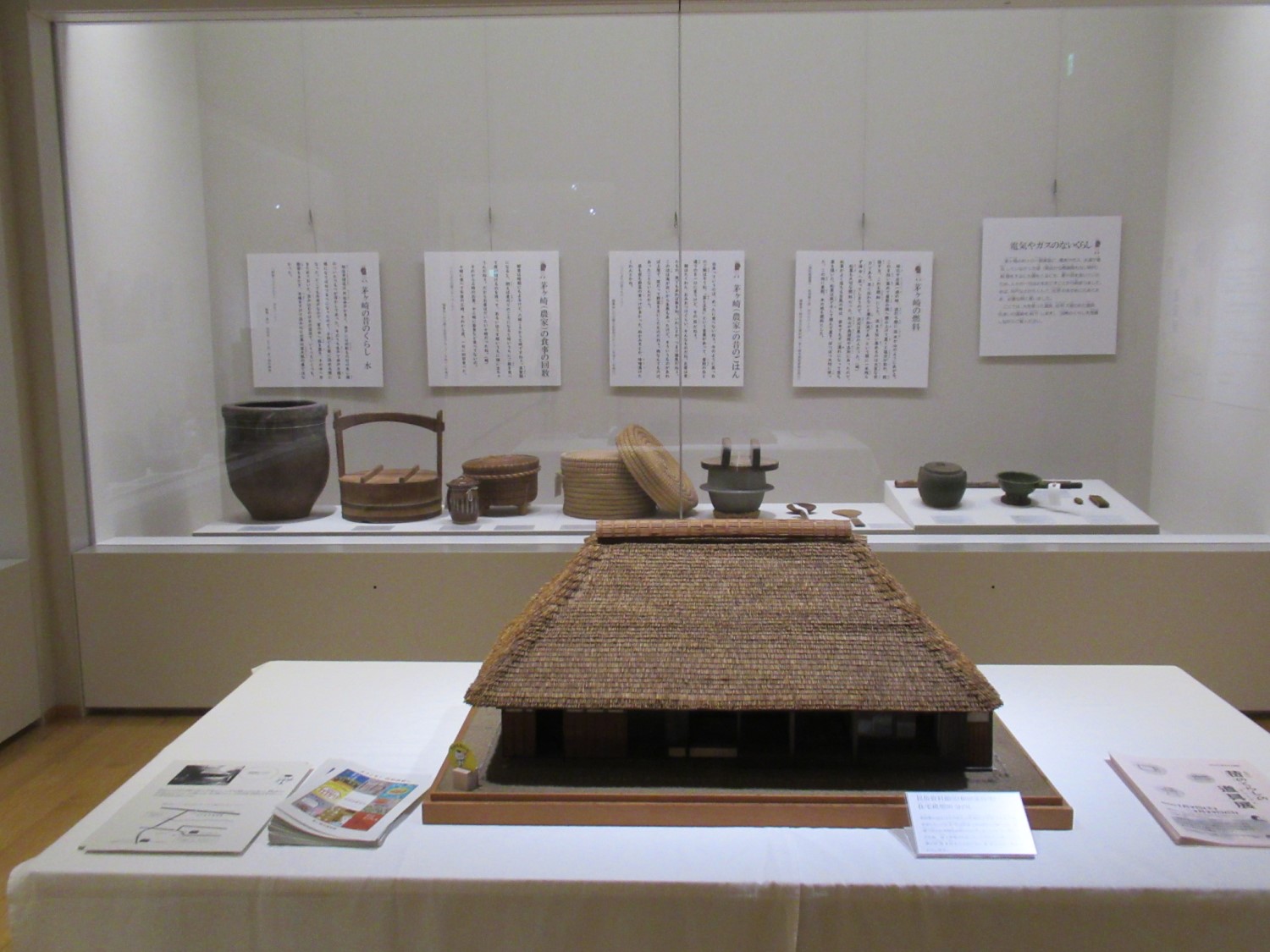
● Exhibition of household items in the 1940s and after
An iron pot, wooden rice-serving tubs, and other kitchen utensils, 28 items in total, used in ordinary households during and after the war are displayed. See the photo above. In the 1950s, a sewing machine, a black-and-white TV, an electric rice cooker, and other home appliances started appearing in many households. Such items, 16 altogether, are placed in the next area. In addition, toys, textbooks, and a school desk and chair, 12 items of the 1950s, as well as twelve photos of those days are also on display.
Four among eight themes have been replaced by new themes in the permanent exhibition room. Two of them are:

● Residents on lowland
The southern part of the city was the bottom of the sea around 10,000 BC due to the sea level rise caused by global warming. Then the globe cooled down, the sea level dropped, and the coast line moved southward. Inhabitants of northern highlands gradually descended to the low area around 400 BC. Earthenware, insects, thin wooden strips used to write on in ancient times, and other articles excavated from the soil of the southern area are displayed. See the photo above.
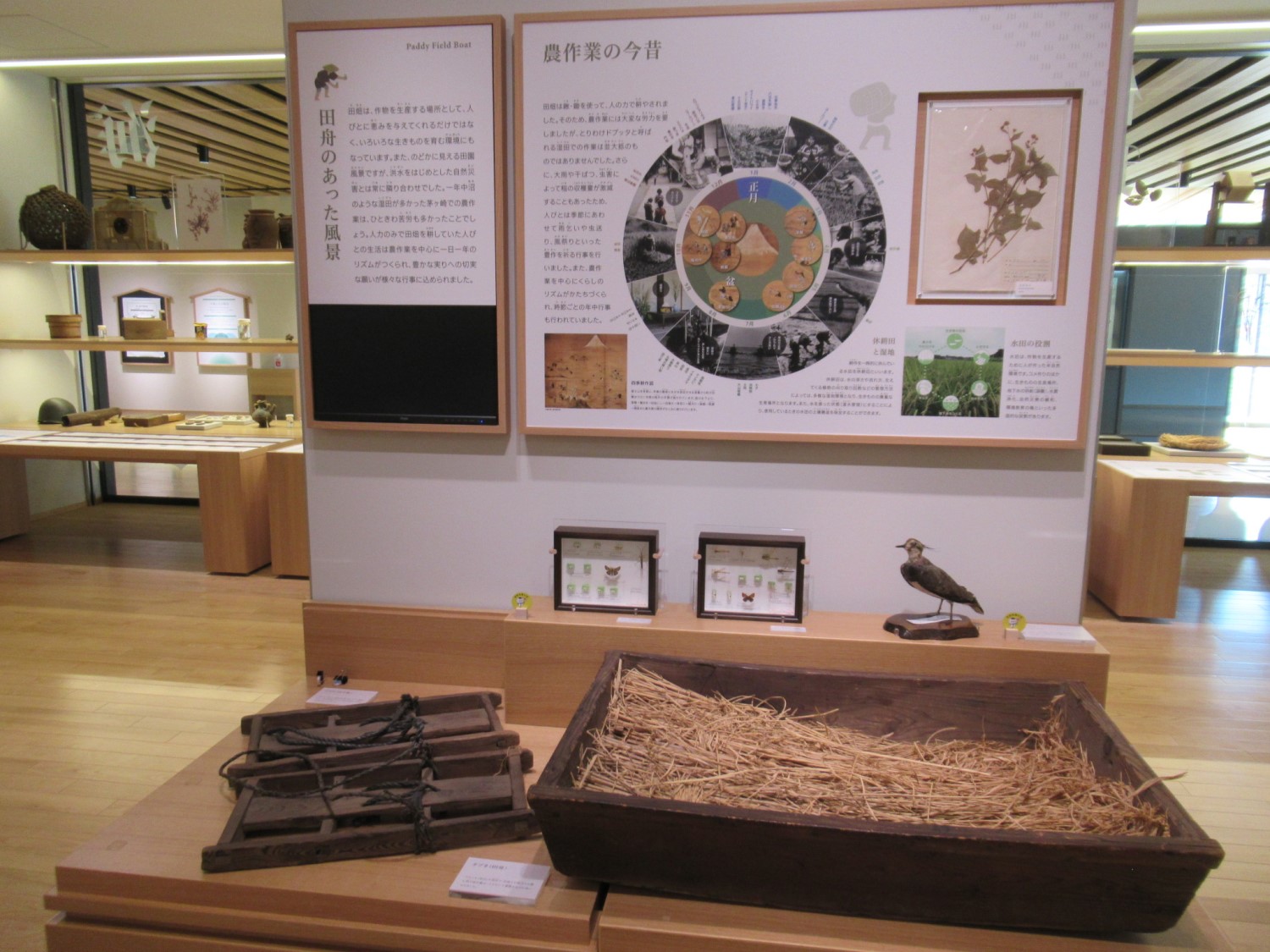
● Landscape - small boats floating on paddy lands
Some paddy fields were covered by water for several months or throughout the year. Farmers used small wooden boats to convey reaped rice, gear, and so on. Paddy field landscapes looked peaceful, but rice growing in such an environment was quite tough, and farmers’ daily lives were monotonous. They were often plagued by torrential rains, drought, and insect damage. Some seasonal events started from their prayers to God for protection from such calamities. Sea the photo sbove.
Flowering season is just around the corner
Camellias in Himuro-en
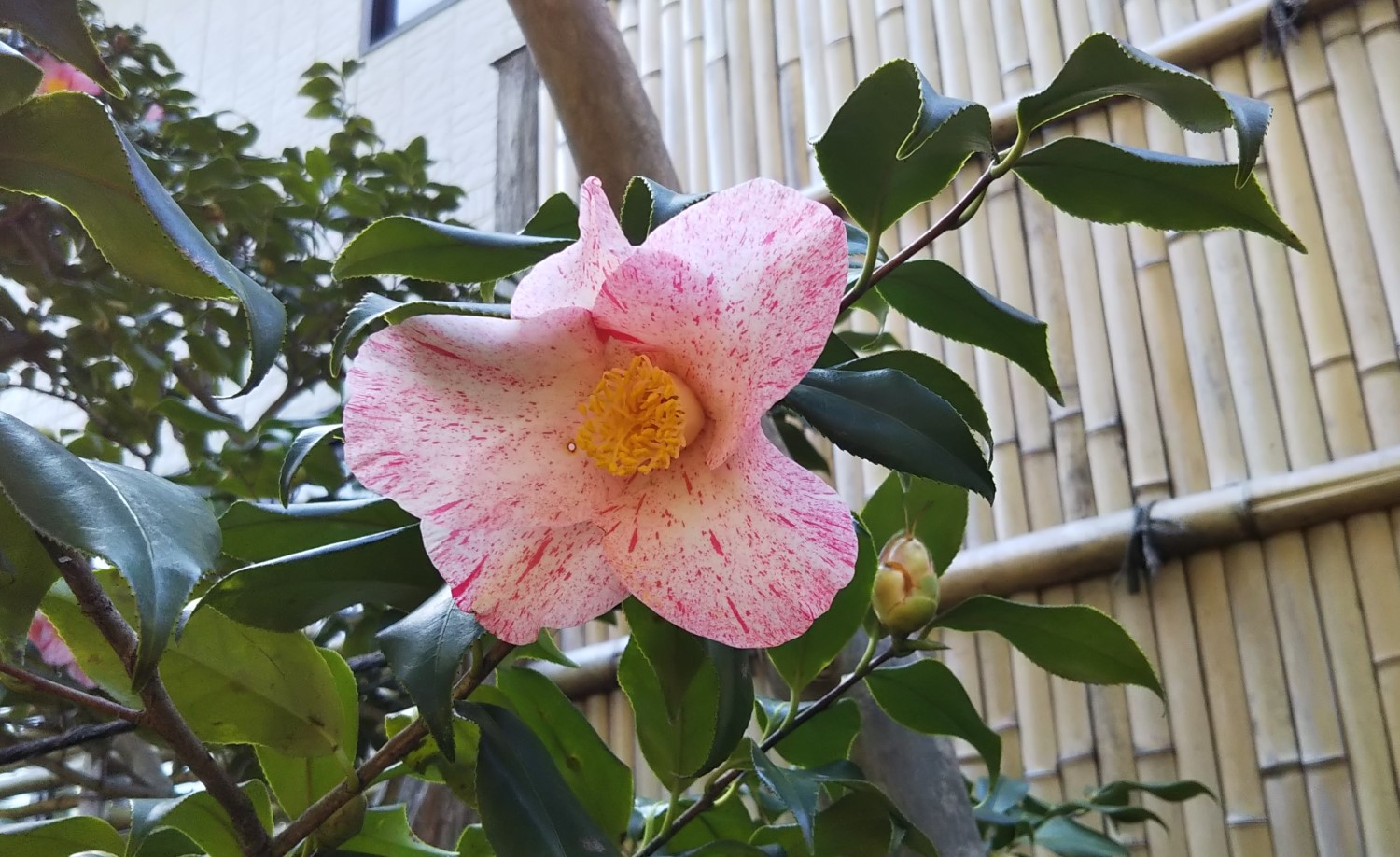
There are over 200 varieties of camellias in Himuro-en, which used to be the residence of the Himuro family. The house was donated to the city, and opened to the public in October 1991. As of February 17 (Fri), many camellia trees are budding, but the buds of several varieties have already bloomed. See the two pictures. Within a month, the garden will be decorated with flowers.
About Himuro-en, go to
https://www.city.chigasaki.kanagawa.jp/kouen/1006491/tsubaki/1006509.html
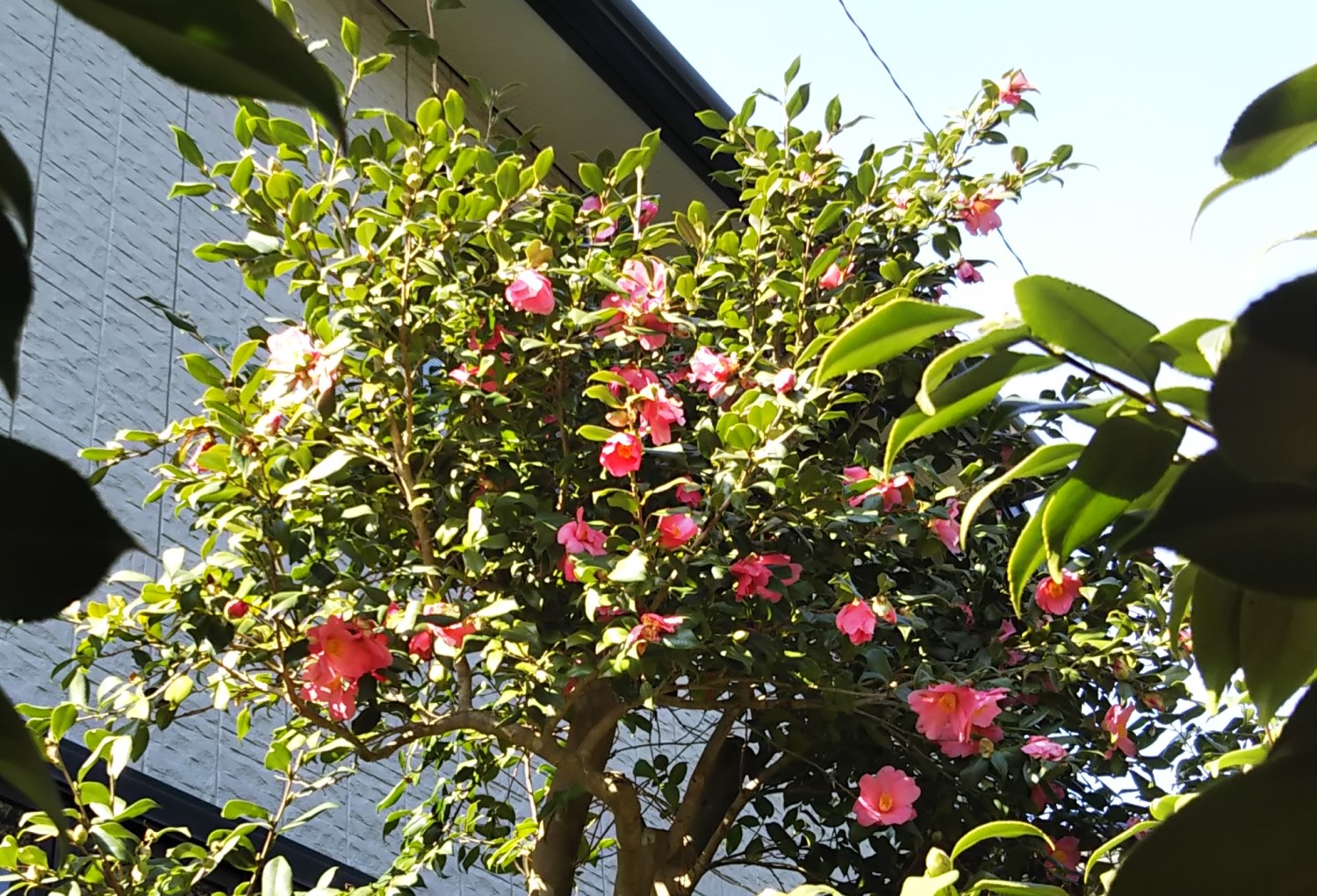
Kawazu-cherry blossoms on the Koide River bank
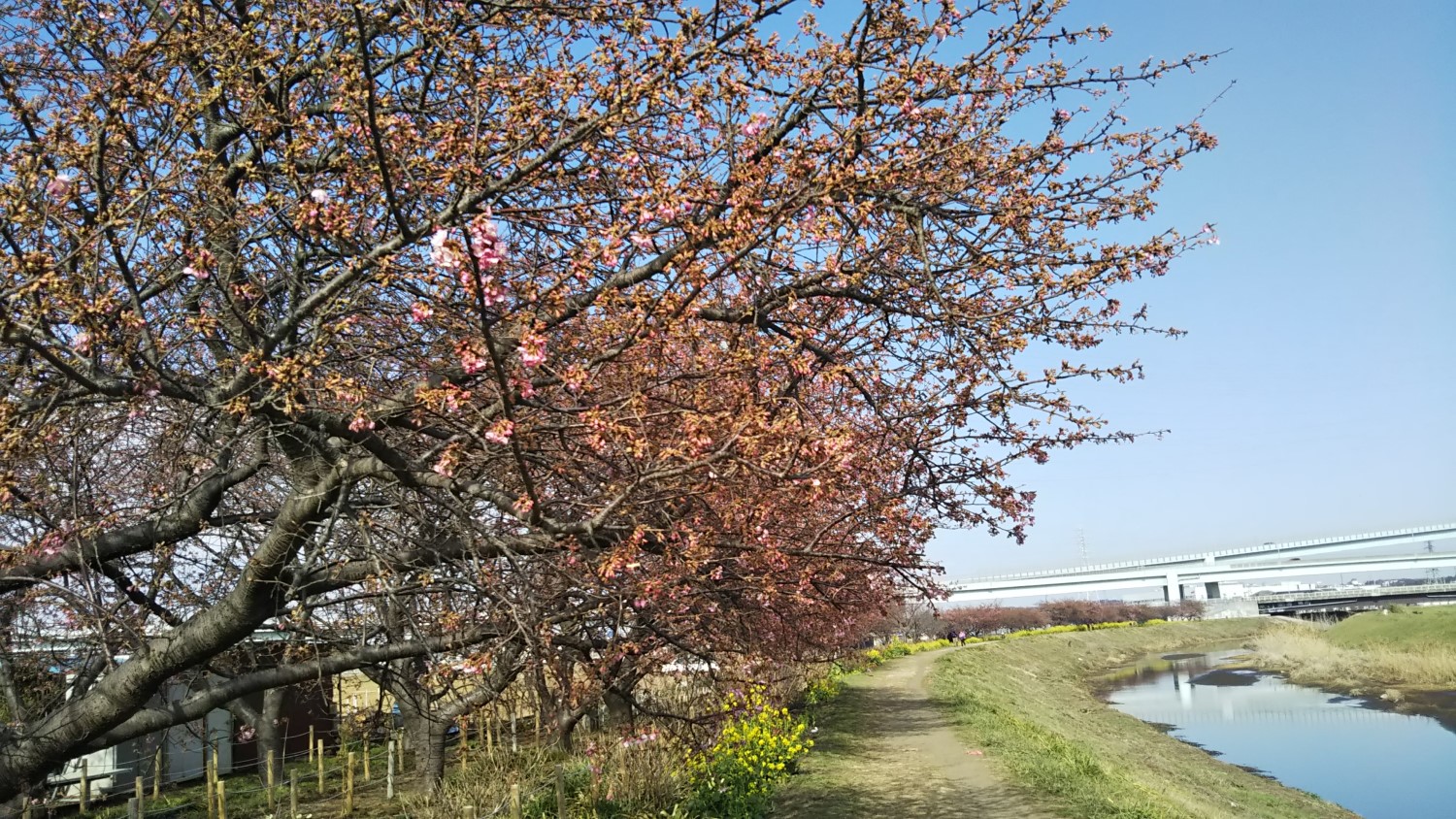
About 70 Kawazu cherry trees on the right bank of the Koide River bloom in early March. The photo above was taken on February 17 (Fri). The cherry festival is usually held from late February to early March, but was cancelled this year, for the fourth year in a row, due to the precautions against Covid-19 and the flu. About the cherry blossom site, go to
https://www.city.chigasaki.kanagawa.jp/kankou_list/koen/kaika/1006962.html
Events in mid-January and February
Calligraphy exhibition by Gagetsu calligraphy school

The tenth exhibition of calligraphy by writing master Gagetsu Inoue and her students was held at Citizen Gallery from January 27 (Fri) to 29 (Sun). Works covering all over the walls ranged widely from beginners’ ‘Hiragana’ to accomplished members’ ‘Kanji’ which overwhelmed visitors. In addition, many kinds of paper with various sizes and textures were used. Some works used ‘Sikisi’, square pieces of thick paper on which famous people write their autograph. Flip-flops on which school children wrote a few words were also on display. The master said she hoped children could practice drawing letters and characters joyfully. In addition, she thinks it is important not only to write beautiful and neat characters but also to show individual characteristics.
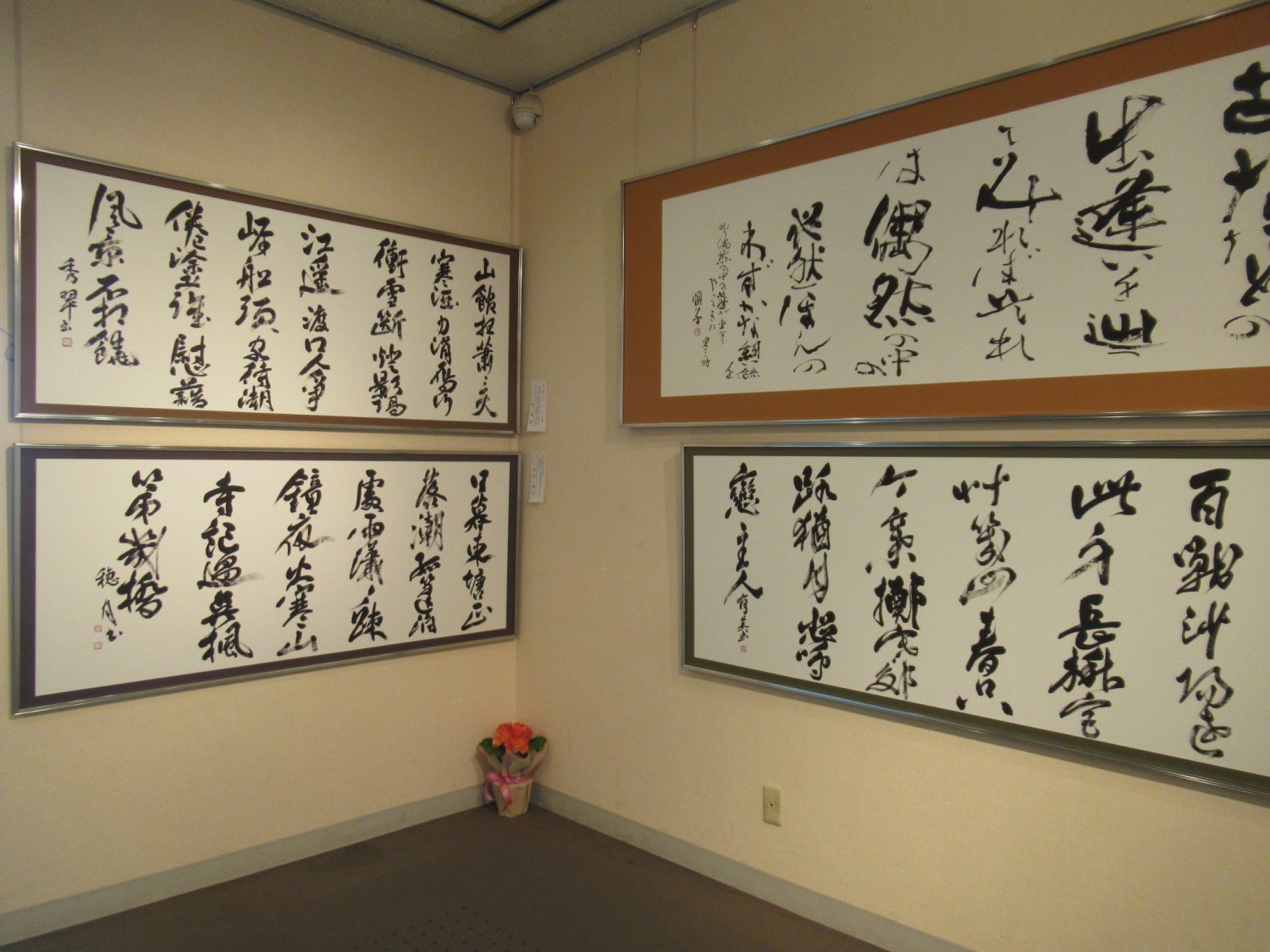
She added that she also hopes that children can develop the power of concentration and the ability to think, as well as behaving politely. Some adult learners aim to become professors, and some write as a hobby. She has lessons three times a month in Nango. Inquiry: tokuko53@yahoo.co.jp
Spring has come

On February 3 (Fri), the Setsubun Festival was held at Samukawa Shrine. Usually bean scattering is carried out by applicants, who were born in the Year of the animal (this year, Rabbit) in Chinese astrology, but only prize exchange was done this year. Four lines of people, about 200 meters long, had formed by around 10:30 am, 30 minutes before the opening of the ritual. From 11:00, visitors were given two small packages which comprised roasted beans and a ticket, and they exchanged the two tickets for prizes. Visitors, mostly adults, seemed to enjoy the spring events. At 14:00, the ritual was conducted again.

Events in late February
Flower exhibition at Shonan Mall Fill
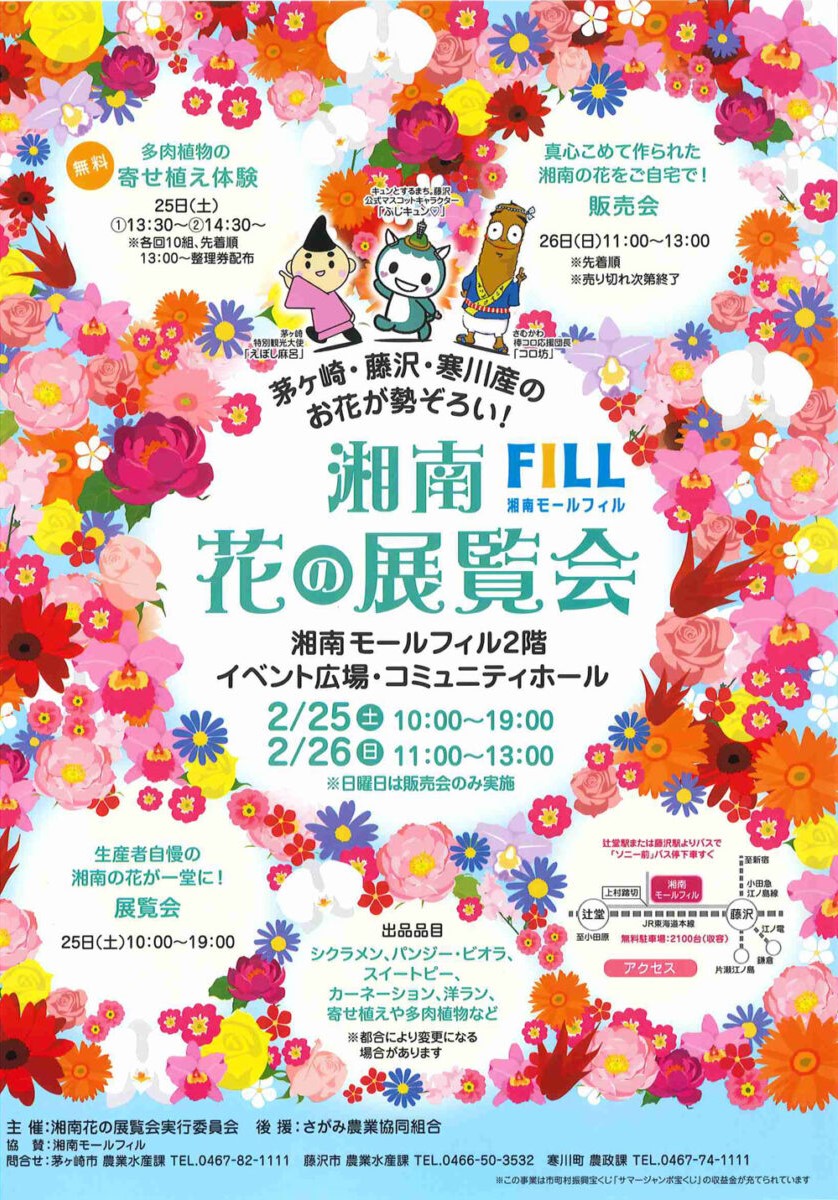
Flowers grown by florists in Chigasaki, Fujisawa and Samukawa will be exhibited and sold on February 25 (Sat) and 26 (Sun) for the first time in three years.
Program ● Feb. 25, 10:00 ~ 19:00
Experience container gardens of fleshy plants from 13:30 ~, and 14:00 ~.
* First ten people for each lesson, numbered tickets will be distributed from 13:00.
● Feb. 26, 11:00 ~ 13:00
Sales of exhibited flowers (on a first-come-first-served basis)